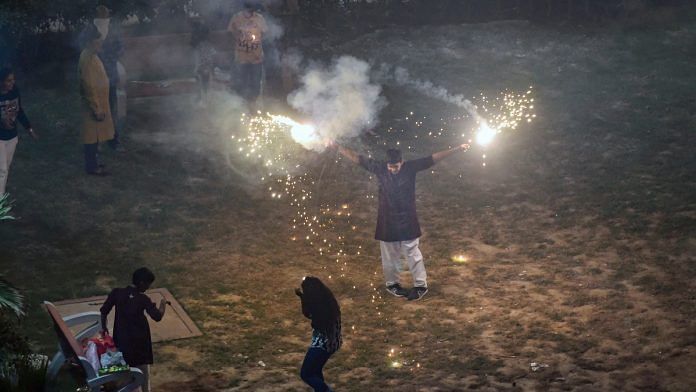New Delhi: Air quality in certain regions turned hazardous in Delhi as pollution monitors hit the maximum reading of ‘999’ late Sunday night. Officials of the Central Pollution Control Board (CPCB), however, insist the situation is much better than what the national capital experienced in the last three years.
The government’s pollution forecasting body SAFAR had predicted that the post-Diwali pollution levels in Delhi were expected to be the lowest as compared to the last three years, with favourable wind speed likely to negate the impact of firecracker emissions and stubble burning.
However, Delhi’s air quality was in the ‘severe’ category Monday as the AQI touched 506 around noon. According to reports, AQI was recorded 999 in the Patparganj area.
Last year, the overall air quality index the day after Diwali was recorded at 642. In 2017, the AQI was 367, while 2016 saw the index recording 425.
Delhi burst firecrackers with impunity despite SC ban
Despite the Supreme Court’s ban, firecrackers were burst in almost all parts of the city. On Twitter, users were even posting videos of bursting banned firecrackers with the hashtag #CrackersWaliDiwali.
#CrackersWaliDiwali that's how my dad ended our 2019 Deepavali… pic.twitter.com/BX1cbF3Kq2
— PJ (@prashu46) October 27, 2019
Former Delhi MLA Kapil Mishra, who is now a BJP member, also tweeted extending support to those bursting crackers.
दिल्ली में हर तरफ धमाकेदार पटाखे चल रहे हैं
पटाखों पर बैन लगें
ऐसा नैरेटिव बनाया गया जैसे हिन्दू अगर दिवाली मनाएगा तो कोई पाप करेगा
I am so Happy & Proud to see full crackers wali Dhamakedar Diwali all across Delhi pic.twitter.com/XqFcvBM1Y7
— Kapil Mishra (@KapilMishra_IND) October 27, 2019
The Narendra Modi government had announced that green crackers — which are designed to emit 30 per cent less pollution than the traditional variants — will be available in the market this year.
However, consumers reported that these were hardly available. Less than a dozen licences were approved for selling green crackers, and these shops too did not offer much variety to the consumers.
AQI levels better than last few years
CPCB official P Krishnamurthy told ThePrint that the AQI levels were better than what was witnessed in the last few years. He said the agency is analysing the readings from Sunday night to understand how firecrackers affected the environment.
SAFAR reported Sunday that fire counts from stubble burning in Haryana and Punjab almost doubled over the previous 48 hours, increasing from 1,200 to 2,700. The share of pollution from biomass is likely to increase over the next few days.
Avinash Chanchal of Greenpeace India, however, said while these episodic events of firecracker bursting and stubble burning make the air worse for breathing, other permanent and regional sources such as transport, industries and power plants contribute to air pollution all around the year and need to be paid attention to.
“This Diwali has proved that governments, and we as a society, both have failed in tackling the pollution from firecrackers, despite all of us trying to make everyone believe that this Diwali will be different, the primary reason behind this failure may be that it was merely an act of tokenism,” Chanchal said.
Also read: Why Kejriwal and Modi govt can’t agree on source of Delhi’s air pollution
What TERI says
“There is an increase of 30 per cent in the levels of PM 2.5 from yesterday,” said Sumit Sharma, director, Earth Sciences and Climate Change of TERI.
“Pollution levels did hit a very high number last night, but then that number did not last for too many hours. It started rising from around 8-9 pm last evening — that is when people start burning crackers. But it peaked out at around 12 am, and then started to come down. The levels in many parts are now almost the same as they were yesterday,” Sharma told ThePrint.
“The meteorological conditions also have a role to play. Wind speed numbers today have improved, which has helped the pollution to disperse faster,” he added.
Sharma said this shows there is an improvement in the civic sense as people are probably bursting crackers within a limit. But the air pollution composition in Delhi is complex — with contributions from firecrackers and stubble burning adding to the year-round sources, Sharma said.
“I think overall pollution is going down. We are moving in the right direction, and probably in a few more years we will see a more effective ban on crackers,” he said.




Why Diwali is always blamed for pollution. Stop the factory pollution, vehicle pollution- but you cannot.
Coming to crackers – As if it is the only festival that uses firecrackers.
Firecrackers are used in the celebration of holidays or festivals, such as Halloween, Independence Day (4th July in the United States), Eid al-Fitr in Southeast Asia, Day of Ashura in Morocco, Guy Fawkes Night or Bonfire Night in the United Kingdom, Halloween in Ireland, Bastille Day in France, Spanish Fallas, on the day any country wins the cricket match and on new year eve and new year day.
Not to forget crackers are burnt daily near Nayagara falls
The war on Diwali crackers is yet another attack on Hindus by the Left lobby. I fully support the people celebrating with firecrackers. The tughlaqesque SC be damned!